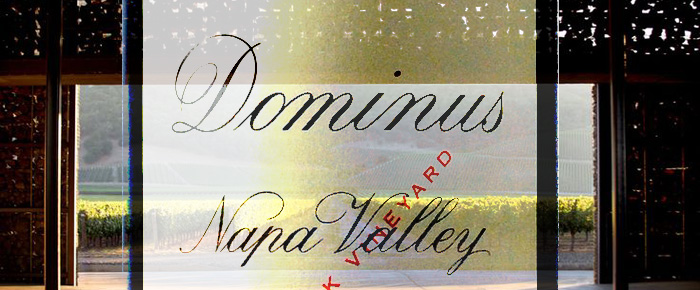
By Rick Riozza
Vino enthusiasts all around the block realize that when there’s a question of whether or not to open a very collectable vintage bottle of wine, the consideration is not particularly the occasion to do so, such as an anniversary or notable birthday, but simply, the occasion is opening that very special bottle of wine in itself.
Well—I can’t seem to follow my own advice: when my son Paolo offered to open his magnum of 2002 Dominus Napa Valley for a weekday steak dinner, I balked, thinking that perhaps we should hold on to that bottle for a more special occasion—at least, for a fancy Sunday night meal. My take was that the Dominus was worthy of the weekend and not for a Tuesday night happening.
Paolo looked at me with that glance of, really dad? Haven’t we discussed this? He’s right! If he wishes to open up a $600 magnum of wine, that’s the occasion to celebrate! Grilling-up a bloody-rare New York steak along with asparagus, artichoke, and a baker would be a basic but fine trimming for joining the celebrated Bordeaux-style red blend Napa wine at the table.
Pouring half the magnum into a decanter for an hour or so of aeration, the wine bloomed and it blossomed. It was all you can imagine; a classic bold brooding full-bodied Napa Cabernet Sauvignon blend (85% Cab Sauv, 8% Cab Franc, remaining Petite Verdot &Merlot)—but in no manner, was it an over-the-top heavy framed fruit bomb.
Surely a beast of a wine only in a sense of its strength and presence. But it was more so an extremely elegant wine, so French with Bordeaux First Growth qualities, like a sexy mélange of a Lafite, Mouton, and Margaux in one bottle (or magnum, as it were).
You can look it up, the 2002 vintage in California, although a bit troubling for some winemakers, turned out to be one of the most notable (that is to say, before global warming and our extended drought caused a line of excellent vintages here).
In fact, 2002 may have changed the way many international wine lovers thought about California Cabernet Sauvignon. Norm Roby, back in 2005, wrote in Decanter Magazine, “The best 2002s have more acid balance, firmer structure, and a sense of grip that is rarely encountered in California Cabernet. They are also fragrant with floral and cedar notes accompanying the usual blackberry, cherry and berry character. The most positive news was that there are few jammy, overripe wannabe blockbusters.
“Every now and then a vintage comes along in California – and I am reminded of 1985 and 1991 – that shifts the style of Cabernet Sauvignon towards muscular and balanced wines with good acidity. In other words, 2002 Cabernet from California will appeal more to the European palate, which appreciates wines that age slowly.”
All this vintage talk—especially when the years discussed pre-date one’s birth!—may seem a bit esoteric. And it’s a good discussion point for the new wine enthusiasts who come on board without that much interest in the past but look ahead to what’s up in the wine biz with global warming and ever-improving wine making: So do vintages matter?—that’s what classic wine collection was all about.
Anyway—so let’s talk about the world famous vintner who produced this wine. Christian Moueix [MOO-icks]. The man whose name has been synonymous with the famous Château Pétrus for more than 40 years has also made a major mark in California with his Napa Valley Dominus.
(Oh no!—again, some real quick wine history: Petrus’ fame in the U.S. grew in the 1960s when the Greek billionaire Onassis sat at his corner table at the restaurant Le Pavillon in New York and continually ordered the wine. After that, Château Petrus became a status symbol. It was kind of the “first cult wine” selling at over $1000 a bottle!—and now sells for over $5000 a bottle!)
Attending UC Davis back in the late 60s, Christian Mouiex’s love of Napa lingered and, in 1981, he discovered the historic Napanook vineyard, a 124-acre site west of Yountville that had been the source of fruit for some of the finest Napa Valley wines of the 1940s and 1950s.
In 1982, Moueix entered into a partnership to develop the vineyard and, in 1995, became its sole owner. He chose the name “Dominus” or “Lord of the Estate” in Latin, to underscore his longstanding commitment to stewardship of the land.
Moueix then hired Swiss architects to design the most modern, gravity-driven & “bio-dynamic” winery of its time. It’s a winery that literally disappears into the earth when the vines flourish and cover the landscape. It’s never open to the public!
As you would expect, our family—at least Paolo and I, were pretty stoked to be experiencing this 2002 Dominus at the table. During its aeration time, of course we would dip into the juice to see how it was evolving and readying itself for the meal. Usually with a delicious cheese platter to munch on, it brings out the best in a quick quaff of wine. In this case, the Dominus was so delicious, even in its opening stage, it brought out the best in the cheese!!
Taking notes for this article, I queried everyone to offer a description of the aromas and flavors. We all chimed in with comments such as, “sweet black currants interwoven with kirsch, forest floor, unsmoked cigar tobacco and new saddle leather.” “Stunning elegance and a 45-second finish.” “Shy aromas of eucalyptus, spice box, dark cherries and licorice.” “Penetrating and powerful, with black fruit and herbal flavors… extraordinary perfume of roasted coffee intermixed with cocoa, cedar, and cigar smoke.”
I think Paolo probably put it most succinctly, “You know . . . it smells like money.” Cheers!










































